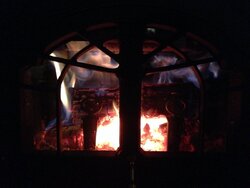I've got a long thread about the selection and installation of my woodstove, but I thought I'd post my question in a new thread so people wouldn't have to suffer through 10 pages of my rambling prose.
So, the Isle Royale has been running steadily for about 24 hours and the glass is sooted up quite a bit. Any idea what I did to cause it? I don't think I've overloaded it or damped it down excessively to a smoldering mess. The wood is well-seasoned hardwood. I'm just wondering if there's something about my method of use that I might improve.
So, the Isle Royale has been running steadily for about 24 hours and the glass is sooted up quite a bit. Any idea what I did to cause it? I don't think I've overloaded it or damped it down excessively to a smoldering mess. The wood is well-seasoned hardwood. I'm just wondering if there's something about my method of use that I might improve.


